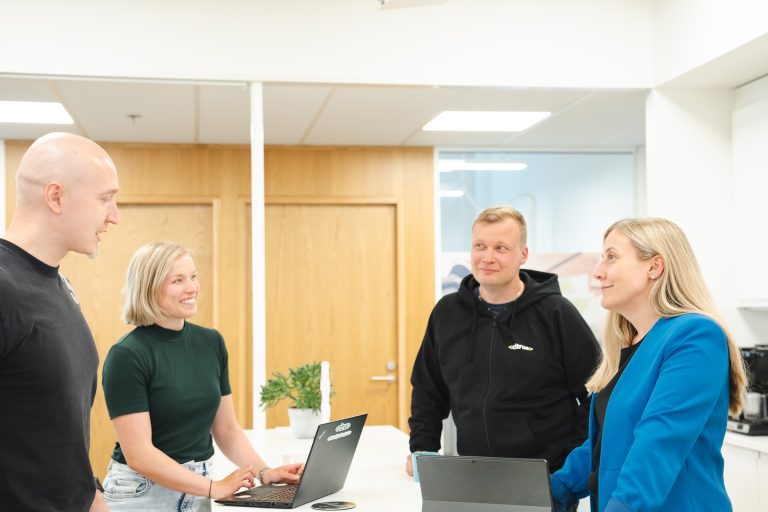
Making the right choice requires understanding of the company's needs and evaluating the benefits and limitations of the offered systems.
Centralized model – efficiency and uniformity
A centralized IT system is generally credited with providing a comprehensive solution that integrates various functions into one system. Advantages of this approach include standardizing processes, which facilitates information management and decision-making. In theory, a centralized system also offers economic scale benefits and allows cost reductions by having fewer separate systems and interfaces.
Advantages:
- Unified processes: Improves transparency and enhances reporting.
- Cost-effectiveness: Maintaining one system may be more cost-effective.
- Standardization: Enables the adoption of best practices within the organization.
Centralized systems also have their challenges. Often a centralized system requires extensive customization, and since the system combines several different areas and functions, compromises may have to be made in terms of individual functions.
Customer-specific modifications also raise the cost of implementation and make the system more challenging and expensive to maintain. The broader the system, the more cumbersome it becomes. This means that adapting it to a changing operating environment is laborius.
In any case, the broader the system is, the more cumbersome it also is, which means that adapting it to a changing operating environment is challenging.
Challenges:
- Inflexibility: May be difficult to quickly adapt to changing business requirements.
- Lack of innovation: Centralized systems may be slow to incorporate new technologies and innovations.
- Compromises: More limited features.
Decentralized model: specialized systems
Specialized solutions provide functionalities for specific parts of a process. This approach allows companies to choose the best available tools for each task. Specialized solutions often operate on a SaaS (Software as a Service) principle.
Advantages:
Best-of-breed solutions, like Noventia, have obvious benefits, especially when the software is offered as a service (SaaS). One of the most apparent benefits is that as the service provider focuses on solving a selected problem area, the outcome can be expected to be more effective than a generic solution. SaaS business model also forces system providers to continuously develop their services, making launching new innovations into systems quick.
From a customer's perspective, best-of-breed strategy is useful as it allows developing processes and possibly changing to systems that support different parts of the process. This reduces the risk of vendor lock and forces solution providers to maintain a high level of service. At the same time choosing a best-of-breed solution allows the customer to share the costs of system development and maintenance with all others developing the system.
- Specialization: Offers customized solutions for specific needs.
- Flexibility: Easy to adapt and update to meet business changes.
- Innovation: Allows quick access to the latest technology in each function.
Challenges:
The biggest weakness of the multi-system model is generally considered to be the fragmentation of data and system architecture, i.e. "too many different systems.” Managing costs can also become a problem in a decentralized model, as costs arise from various sources.
Specialized system providers naturally strive to mitigate these problems, and system integrability is an area of focus. At Noventia, we provide standard interfaces to those parts of the system that are typically connected to our customers' other system architectures.
- Integration complexity: Sometimes, combining systems can be challenging.
- Administrative costs: Complexity and maintaining multiple systems can increase expenses.
How to make the right choice?
In the selection process, it is important to assess the size of the company, the industry, strategic goals, and specific needs. Companies operating in a static environment may benefit from the standardization and scale advantages of a centralized system, while companies in a rapidly evolving environment may appreciate the efficiency and flexibility offered by specialized solutions.
Combining solutions: Best of Both Worlds
In many cases, companies can benefit from a hybrid solution that combines the comprehensiveness of a centralized system with the advantages of specialized solutions. This approach requires effective integration and information management but can offer the best possible flexibility and efficiency for the company. Here are some strategic perspectives:
- Business needs: Understand your organization's needs and how different systems can meet them.
- Technological readiness: Evaluate your company's ability to manage and integrate complex IT solutions.
- Cost-benefit analysis: Calculate the total costs, including system maintenance, updates, and potential integrations.
There is no single correct answer in choosing; it depends on the specific needs, goals, and resources of the company. Centralized systems offer simplification and efficiency, while best-of-breed solutions provide specialization and flexibility. In some cases, a combination of both may be the best solution, balancing the needs for efficiency and specialization.
Conclusion
In the digital era's business world, flexibility, efficiency, and the ability to respond quickly to changing market conditions are crucial. In selecting systems, it is important to carefully weigh the benefits of centralized solutions' uniformity and control against the efficiency and flexibility of specialized solutions like Noventia. The final decision should be based on the company's strategic objectives, operating environment, and future growth prospects.
If you wish to discuss the questions on how to consider suitable solutions for your needs, feel free to contact us. We are happy help you!

